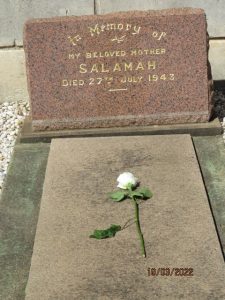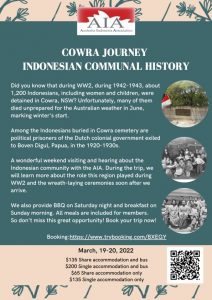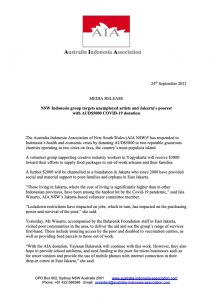
In the small Australian country town of Cowra, about 300 km inland from Sydney, lie 13 Indonesian graves. They are located in the public cemetery beautifully maintained by Cowra Council. So who are these Indonesians who died far from their homeland?
The story goes back to World War II. Then, the Japanese were in control of a large part of Papua. The Dutch feared that the Japanese might reach Boven Digul, release the Indonesian political prisoners held there and use them for political purposes. So, in 1943, the Dutch decided to transfer these prisoners and their families to Australia, where the NEI government in exile was already established and where there were already thousands of Indonesians, many service members with KNIL or seamen with KPM.
The Digulists were first flown by the Dutch Navy Catalina flying boat to Horn Island at the northern tip of Australia. They then travelled by ship to Sydney and Brisbane and finally by train to Cowra, where they arrived on June 25. The 500 Digulists were then held in the sizeable prisoner-of-war camp nearby. This camp already held thousands of POWs, mainly from Italy and Japan. In addition, the centre had held nearly 700 striking KPM seamen from Indonesia the previous year. They were striking because of their low wages compared to their Australian counterparts, particularly as they were required to undergo the dangers of serving in the war zone of New Guinea.
Now, June is the middle of winter in Australia, and Cowra can be very cold. Some of the Digulists were not in good health and did not survive. Some babies were born, and one or two did not survive either. These are the Indonesians who lie buried in Cowra. When the Australian government realised that the Digulists were not criminals but rather political prisoners, they were all released from Cowra within a year. After the end of the war, they were repatriated to Indonesia. Some, such as Mohamad Bondan, married Australian women who joined them in Indonesia.
The Australia Indonesia Association ( AIA ) was founded in Sydney in July 1945 to support the Indonesian independence movement and promote good relations between Australia and Indonesia. In March, the AIA made a weekend pilgrimage to Cowra to honour the sacrifice of those buried there. A bus was hired to travel from Sydney. The AIA party comprised about 40 people., The Indonesian Consul General Bp Vedi Kurnia Buana represented the Indonesian government. Representatives were also sent from the KBRI in Canberra, the AIA in Canberra, and the Indonesian Diaspora and Community organisations.
The hosts were the Cowra Council, assisted by Mr Graham Apthorpe of the local historical society, the Breakout Association. This name relates to the massive escape of over 200 Japanese POWs in 1944. At the gravesite, the Mayor of Cowra, Mr Bill West, made a speech recognising the Indonesians’ sacrifice, to which Bp Vedi responded. Wreaths were then placed by the organisations represented.
The occasion was particularly moving for two of the AIA party. Jan Lingard, the author of “Refugees and Rebels”, the definitive book on Indonesians in Australia during WW2, had known one of the Indonesian internees, Siti Chamsinah, a teenager during her time in Cowra. Jan was also instrumental in having the Indonesian graves identified and restored. Another lady, Isla Winarto, whose father, Andries Sorongan, is a Pahlawan Revolusi and lies buried in Taman Makam Pahlawan, Kalibata, proudly wore her father’s medals. It should also be mentioned that every November, around Indonesian Heroes Day, the KBRI and KJRI organise a formal ceremony at the gravesite.
As guests of the AIA, 4 Indonesian postgraduate students were included in the AIA party undertaking PhDs at universities in Sydney, some with families. The committee of the AIA felt it essential that these visitors from Indonesia have the opportunity to experience this piece of Indonesian history in Australia, as well as to see some of the Australian countryside and experience some Australian hospitality. Therefore, these Indonesian students appreciated the opportunity to join the pilgrimage.
Cowra Council provided a wonderful dinner on Saturday night at which gifts were exchanged, and Jan Lingard spoke of the experiences of the Indonesians interned in Cowra. On Sunday morning, Graham Apthorpe and Neil Smith of the AIA conducted a tour at the site of the POW camp on the outskirts of town.
There was also an opportunity to view the site of the proposed Indonesian memorial park, which overlooks the area of the POW camp.








